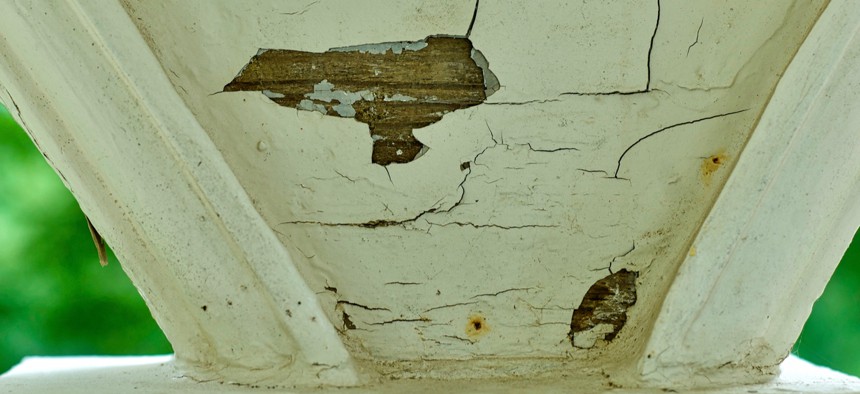Report Highlights Areas for Improvement in Lead-Mitigation Programs

Houses built before 1978 are most at risk for hazards from lead paint. Shutterstock

Connecting state and local government leaders
A recent report from the nonpartisan Government Accountability Office outlined a list of strategies for the Department of Housing and Urban Development to strengthen oversight and inspections.
The federal Department of Housing and Urban Development could strengthen existing programs to address lead-paint hazards in high-risk areas, including the Midwest, the Northeast and the greater Los Angeles area.
A report issued this week by the nonpartisan Government Accountability Office outlined a list of strategies for HUD to improve its programs, including strengthening oversight of public housing complexes and ramping up its inspection process.
“We identified several limitations with HUD’s monitoring efforts, including reliance on public housing agencies’ self-certifying compliance with lead paint regulations and challenges identifying children with elevated blood lead levels,” the report says. “Additionally, HUD lacks detailed procedures for addressing non-compliance consistently and in a timely manner. Developing a plan and detailed procedures to address non-compliance with lead paint regulations could strengthen HUD’s oversight of public housing agencies.”
Lead paint hazards in houses are the most common source of lead exposure for children in the U.S., according to the GAO. Lead-based paint was banned in housing in 1978, but a “significant amount” of homes built before then may contain the paint. Areas with high concentrations of older properties, as well as places with high poverty rates, are most at risk.
Children, particularly infants and toddlers, are at a much greater risk of lead exposure than adults because they crawl on floors that may contain lead dust from chipping or flaking paint, then place their hands and other objects in their mouths.
When absorbed into the body, lead can damage the brain and nervous system, slow development and growth and cause learning or behavioral problems. There is no safe blood level for lead, according to the Centers for Disease Control and Prevention.
To help mitigate the danger for children living in low-income housing, HUD awards grants to states and municipalities to address lead paint hazards. In the past five years, HUD awarded approximately $500 million in grants, mostly in jurisdictions in the Northeast and Midwest, which have a high prevalence of lead paint hazards.
Other areas with elevated risk levels include the greater Los Angeles area and the San Francisco Bay Area. (GAO has an interactive map highlighting other at-risk areas.)
The government accountability report highlighted four areas for improvement for HUD’s grant and rental assistance programs. Those include:
- Better documentation and evaluation of grant selection criteria. “HUD’s guidance is not sufficiently detailed to ensure consistent and appropriate grant award decisions,” the report says. “Better documentation and evaluation of HUD’s grant program processes could help ensure that lead grants reach areas at risk of lead paint hazards.”
- Strengthening inspection standards, particularly in the housing-voucher program, which helps disadvantaged populations acquire safe and sanitary housing on the private market rather than in public housing.
- Establishing more comprehensive performance measures and reporting standards for lead-reduction efforts. HUD has not complied with annual statutory reporting requirements for more than 20 years, per the report.
Read the full report here.
Kate Elizabeth Queram is a Staff Correspondent for Government Executive’s Route Fifty and is based in Washington, D.C.

NEXT STORY: States Sue Trump Administration as Feds Deny Mayors Entry to Detention Center




